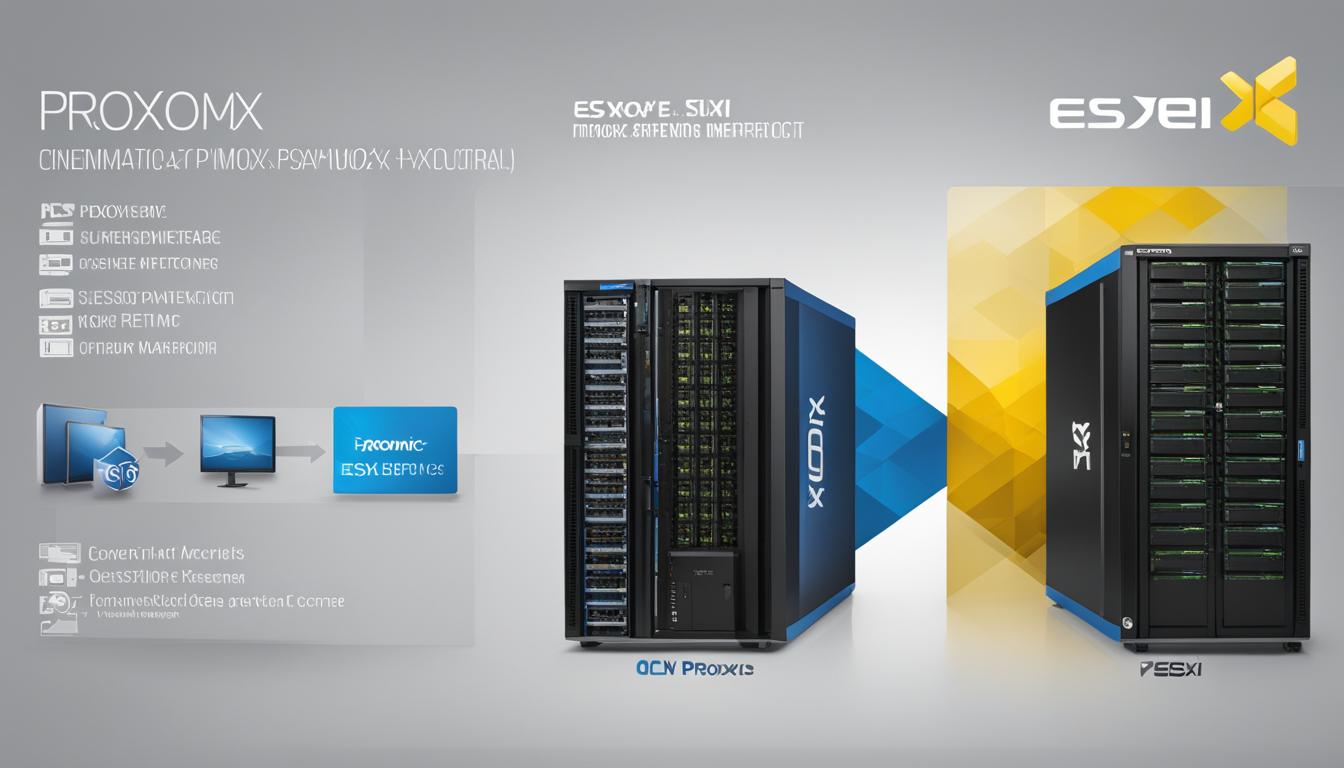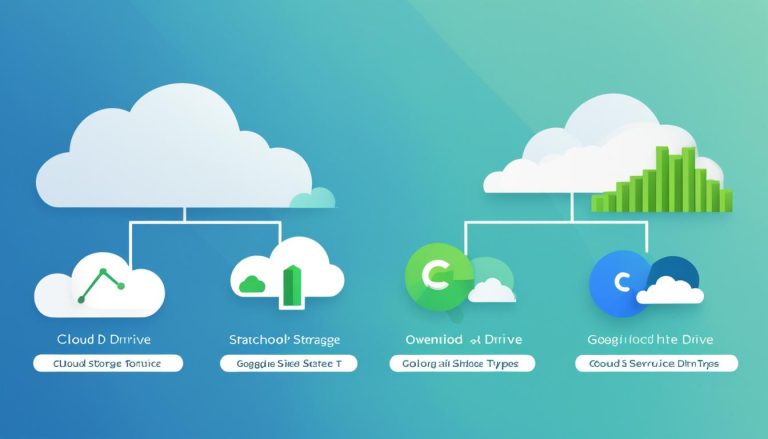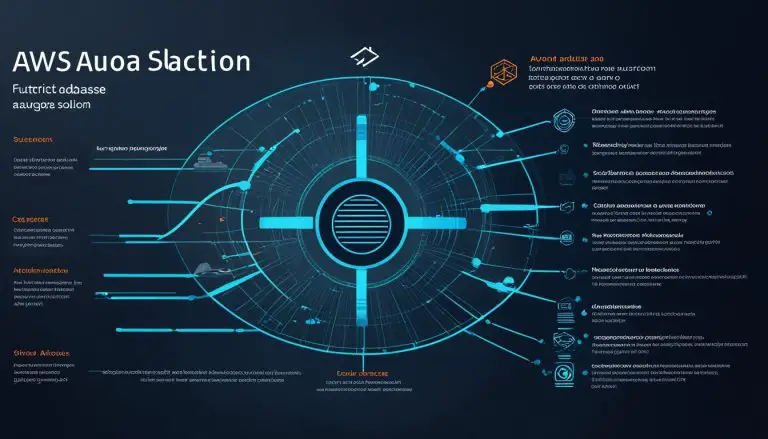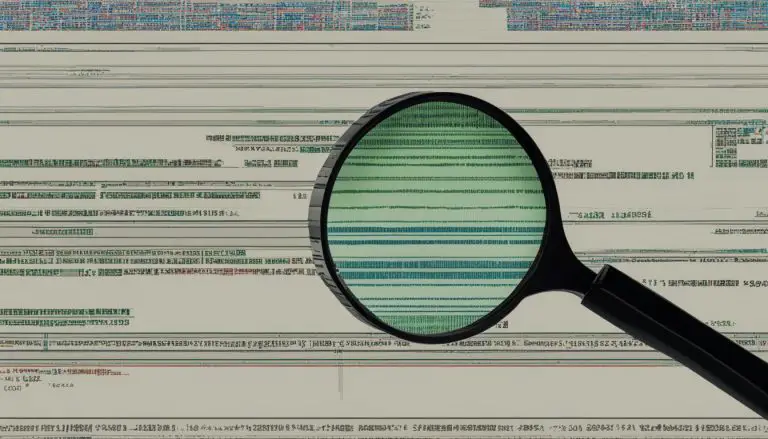ESXi vs Proxmox: A Comprehensive Comparison Guide
In this article, I will provide a comprehensive comparison of two popular type-1 hypervisors, ESXi and Proxmox, to help you make an informed choice for your virtualization needs. Both ESXi and Proxmox are virtualization software used for creating and running virtual machines (VMs). In this comparison, we will explore their features, performance, clustering capabilities, ease of use, security, pricing, and more.
Proxmox VE is an open-source software based on Debian Linux that offers KVM full virtualization and lightweight Linux containers (LXC) for running Linux apps. On the other hand, ESXi is a bare metal hypervisor developed by VMware as part of their vSphere virtualization suite. Join me as we dive into the world of virtualization and compare ESXi and Proxmox to help you determine which hypervisor is the right choice for your virtualization environment.
Key Takeaways:
- ESXi and Proxmox are both popular type-1 hypervisors for virtualization.
- Proxmox VE is open-source and offers KVM full virtualization and lightweight Linux containers.
- ESXi is a bare metal hypervisor developed by VMware as part of their vSphere virtualization suite.
- We will compare their features, performance, clustering capabilities, ease of use, security, and pricing.
- Consider your specific needs, preferences, and budget to choose the right hypervisor for your virtualization environment.
Understanding Hypervisors: Type-1 vs Type-2
When it comes to virtualization, it’s important to understand the different types of hypervisors available. Hypervisors can be classified into two main categories: type-1 and type-2. These categories refer to the way the hypervisor operates and its relationship with the host machine’s hardware and operating system.
Type-1 hypervisors, such as Proxmox and ESXi, are also known as bare metal hypervisors. They run directly on the host machine’s hardware, without the need for an operating system. This allows for native or bare metal virtualization, where the hypervisor has direct control over the hardware resources. This type of hypervisor offers better performance and resource utilization compared to type-2 hypervisors.
On the other hand, type-2 hypervisors, like VirtualBox or VMware Workstation, run as software within the host machine’s operating system. This means that the hypervisor relies on the host operating system for resource management. While type-2 hypervisors are easier to install and use, they typically have lower performance and resource utilization compared to type-1 hypervisors.
Understanding the differences between type-1 and type-2 hypervisors is crucial in selecting the right solution for your virtualization needs. Type-1 hypervisors, such as Proxmox and ESXi, provide better performance and are more suited for enterprise environments where resource utilization and performance are critical factors. Meanwhile, type-2 hypervisors are often used for desktop virtualization or testing environments where ease of use and convenience are prioritized.
| Type-1 Hypervisors | Type-2 Hypervisors |
|---|---|
| Run directly on host machine hardware | Run as software within the host operating system |
| Provide native or bare metal virtualization | Rely on host operating system for resource management |
| Better performance and resource utilization | Lower performance and resource utilization |
| Suited for enterprise environments | Used for desktop virtualization or testing environments |
In conclusion, understanding the differences between type-1 and type-2 hypervisors is crucial in selecting the right virtualization solution for your needs. Type-1 hypervisors like Proxmox and ESXi provide better performance and are ideal for enterprise environments, while type-2 hypervisors are more suited for desktop virtualization or testing environments where ease of use is prioritized. Consider your specific requirements and resources when choosing the right hypervisor for your virtualization projects.
Features of Proxmox
Proxmox VE is a comprehensive virtualization management platform that offers a wide range of features for server virtualization. With its user-friendly web-based GUI and powerful command-line interface (CLI), Proxmox VE provides a flexible and intuitive management experience for virtual machines (VMs), containers, and associated resources.
One of the standout features of Proxmox VE is its high-availability cluster management, which allows you to create clusters of up to 32 physical nodes. This ensures redundancy and fault tolerance, making your virtual environment highly resilient. Proxmox VE also supports live migration capabilities, allowing you to seamlessly transfer running VMs between physical hosts without any downtime.
Another notable feature of Proxmox VE is its built-in backup server. This feature enables you to create incremental backups of VMs, ensuring the safety and recoverability of your virtual machines. Proxmox VE also employs a database-driven file system, which synchronizes configuration files across nodes to maintain consistency and simplify management. Furthermore, Proxmox VE offers third-party support through a RESTful API, allowing you to integrate and automate various tasks and workflows.
Proxmox VE also prioritizes security, offering built-in firewalls and various options for VM image storage. The integrated firewalls provide granular control over network traffic, while the VM image storage options allow you to choose the most suitable method for your environment. These security features contribute to a robust and secure virtualization platform.
Table: Proxmox Features
| Feature | Description |
|---|---|
| High-Availability Cluster Management | Create clusters of up to 32 physical nodes for redundancy and fault tolerance. |
| Live Migration | Transfer running VMs between physical hosts without any downtime. |
| Backup Server | Create incremental backups of VMs for safety and recoverability. |
| Database-Driven File System | Synchronize configuration files across nodes for consistency and ease of management. |
| Third-Party Support | Integrate and automate tasks and workflows through a RESTful API. |
| Integrated Firewalls | Ensure network security with granular control over traffic. |
| VM Image Storage Options | Choose the most suitable method for storing VM images. |
Features of ESXi
In this section, we will explore the features of ESXi, one of the leading hypervisors in the virtualization market. ESXi offers a range of powerful capabilities that make it a popular choice for enterprise environments. Let’s take a closer look at some of its key features:
- vSphere Web Client: ESXi provides a user-friendly interface through the vSphere web client. This web-based management tool allows users to efficiently manage virtual machines, hosts, and datastores. With its intuitive design and advanced configuration options, the vSphere web client enhances the overall user experience.
- vCenter Server: ESXi is tightly integrated with vCenter Server, a centralized management platform. By using vCenter Server, users can effectively manage multiple ESXi hosts, clusters, and resource pools. It provides advanced features such as load balancing, high availability, and distributed resource scheduling.
- ESXi Backup Solutions: To ensure data protection and business continuity, ESXi offers various backup and restoration options. These include using REST APIs to automate backup processes and integrating with the vCenter Server Appliance for centralized backup management. These features enhance the reliability and security of virtualized environments.
With its robust management tools, seamless integration with vCenter Server, and backup solutions, ESXi empowers organizations to efficiently manage their virtual infrastructure.
| Feature | Description |
|---|---|
| vSphere Web Client | |
| vCenter Server | 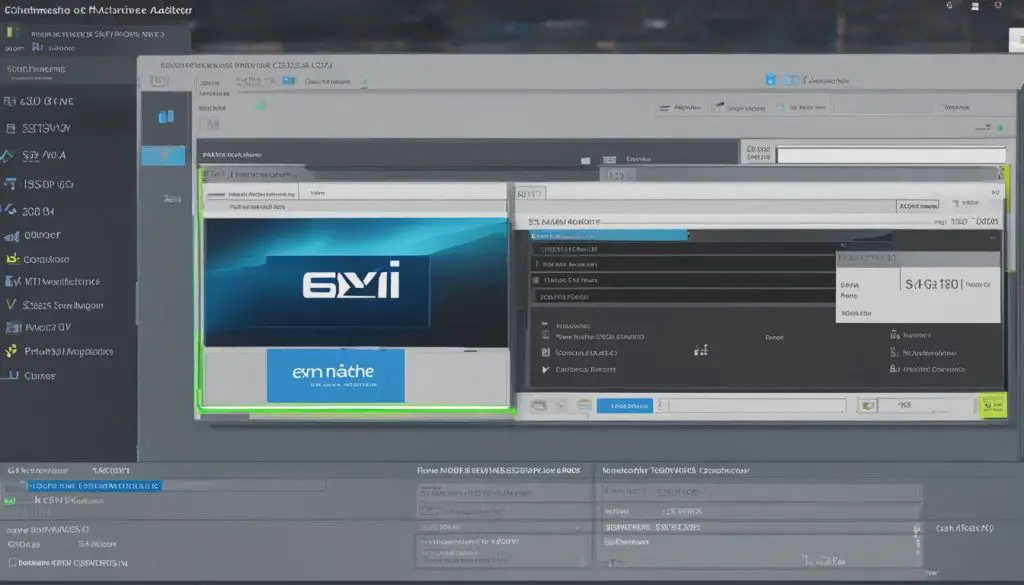 |
| ESXi Backup Solutions |
Performance Comparison
When it comes to performance, both Proxmox and ESXi are highly capable hypervisors. However, there are some key differences to consider. Let’s take a closer look at their performance metrics, RAM capacity, and host capacities.
RAM Capacity
Proxmox offers support for up to 12TB of physical memory, making it suitable for environments that require high memory allocation. On the other hand, ESXi takes it a step further with support for up to 24TB of physical memory. This additional capacity can be beneficial for organizations that require extensive memory resources for their virtual machines.
Host Capacities
When it comes to the number of hosts that can be managed, Proxmox allows for up to 32 hosts per cluster. ESXi, however, extends its capacity, supporting up to 96 hosts per cluster. This higher host capacity can be advantageous for large-scale deployments and enterprises with a significant number of servers.
| Proxmox | ESXi | |
|---|---|---|
| RAM Capacity | Up to 12TB | Up to 24TB |
| Host Capacities | Up to 32 hosts per cluster | Up to 96 hosts per cluster |
As evident from the comparison, ESXi surpasses Proxmox in terms of RAM capacity and host capacities. However, it’s important to note that the specific requirements of your virtualization environment should guide your decision-making process. Consider factors such as the number of virtual machines and hosts you anticipate, as well as the expected memory usage.
Ultimately, the performance comparison between Proxmox and ESXi showcases their capabilities in different areas. Assess your specific needs and prioritize the performance metrics that align with your virtualization goals to make an informed decision.
Clustering Capabilities
Both Proxmox and ESXi offer robust clustering capabilities, allowing users to effectively manage multiple servers and enhance the performance and reliability of their virtual environments.
Proxmox Clustering
With Proxmox, users have the ability to create clusters of up to 32 physical nodes. This clustering feature enables centralized management of multiple servers through a user-friendly web management console. Proxmox’s clustering functionality provides essential features like high availability and live migration, allowing for seamless workload balancing, fault tolerance, and improved resource utilization. The intuitive interface of Proxmox’s web management console makes it easy for administrators to monitor and manage their clustered servers without the need for complex configurations.
ESXi Clustering with vCenter Server
ESXi requires the use of vCenter Server for creating and managing clusters. With vCenter Server, users can have multiple hosts that provide processing, memory, and network resources to the cluster configuration. This allows for efficient load balancing, high availability, and improved application performance. vCenter Server also enables advanced features such as Distributed Resource Scheduler (DRS) for automated workload optimization, Distributed Power Management (DPM) for energy efficiency, and High Availability (HA) for fault tolerance. The use of vCenter Server in ESXi clustering provides a comprehensive solution for managing and scaling virtual environments in enterprise settings.

Overall, both Proxmox and ESXi offer powerful clustering capabilities that enhance the scalability, availability, and performance of virtualized environments. Proxmox’s web management console provides a straightforward approach to cluster management, making it ideal for small to medium-scale deployments. On the other hand, ESXi’s integration with vCenter Server offers advanced features and scalability suitable for enterprise-level environments. The choice between Proxmox and ESXi clustering depends on the specific needs and requirements of the virtualization project.
Ease of Use
When it comes to ease of use, both Proxmox and ESXi offer intuitive interfaces and management tools. Proxmox stands out with its integrated GUI, which allows users to complete all management tasks in one place. The web interface, based on the ExtJS JavaScript framework, supports all browsers, providing a seamless experience for users.
ESXi, on the other hand, utilizes the vSphere web client for VM management. This client offers an intuitive interface with advanced configuration features, giving users greater control over their virtual environment. However, it’s worth noting that using ESXi effectively may require users to learn VMware’s proprietary Linux and management tools.
Overall, both Proxmox and ESXi provide user-friendly interfaces and management tools, making it easy for administrators to set up and manage their virtual infrastructure.
Proxmox GUI
- User-friendly web-based GUI
- Integrated management of all tasks
- Supports all browsers
ESXi Management Tools
- vSphere web client for VM management
- Intuitive interface with advanced configuration features
- Requires learning VMware’s proprietary Linux and management tools
Security Features
When it comes to virtualization, security is a top concern for any organization. Both Proxmox and ESXi have implemented robust security features to ensure the protection of virtual environments.
Proxmox Security
Proxmox offers a range of built-in security features to safeguard your virtual platform. One of its key security measures is the integrated firewalls that provide separate controls for macros, security groups, aliases, and IP sets. This allows for granular control over network traffic, enhancing the overall security of your virtual infrastructure. Additionally, Proxmox has a data encryption feature that helps protect the integrity of your data, ensuring that sensitive information remains secure.
ESXi Security
ESXi also prioritizes security and has implemented various measures to protect virtual environments. By default, ESXi runs only essential services, minimizing potential attack vectors. It also disables Shell and SSH interfaces by default, further reducing the surface area for potential security breaches. Additionally, ESXi offers advanced security options such as encryption and role-based access control, allowing administrators to enforce strict security policies and limit access to sensitive resources. Through its logging and auditing capabilities, ESXi provides administrators with valuable information to proactively monitor and respond to security incidents.
Both Proxmox and ESXi offer secure designs and help maintain a secure virtual platform. However, it is important to note that the overall security of your virtual environment depends on various factors, including the implementation of best practices, regular updates, and strong authentication mechanisms.
| Security Features | Proxmox | ESXi |
|---|---|---|
| Integrated Firewalls | Yes | No |
| Data Encryption | Yes | No |
| Default Service Minimization | No | Yes |
| Role-Based Access Control | No | Yes |
As shown in the table above, Proxmox offers integrated firewalls and data encryption, providing a comprehensive approach to security. On the other hand, ESXi focuses on default service minimization and role-based access control, aiming to reduce attack vectors and enforce strict access policies. It is essential to evaluate these security features in the context of your organization’s specific requirements and compliance standards to make an informed decision.
Pricing and Licensing
When it comes to pricing and licensing, there are some key differences between Proxmox and ESXi. Proxmox VE is an open-source software and is completely free to use. This means that you can access all of its features without any cost. However, Proxmox also offers subscription plans that provide access to enterprise repositories and technical support, which can be beneficial for businesses that require additional assistance.
On the other hand, ESXi is available as part of the free vSphere hypervisor. The free version of ESXi has certain limitations and requires a license after 60 days. It also lacks backup solutions in the vCenter app, which can be a drawback for some users. If you require advanced features and support options, you will need to purchase a paid license for ESXi.
Overall, both Proxmox and ESXi offer free versions that provide access to their core features. However, if you need additional support or advanced capabilities, you may need to consider investing in a subscription or paid license.
| Proxmox Pricing | ESXi Pricing |
|---|---|
| Free to use | Free vSphere hypervisor |
| Subscription plans available for additional support | Paid license required for advanced features |
It’s important to carefully evaluate your virtualization needs and budget when considering the pricing and licensing options for Proxmox and ESXi. Determine the level of support and functionality required for your specific environment to make an informed decision.
Conclusion
After comparing Proxmox and ESXi, two powerful hypervisors, it is clear that both have their own unique features and benefits. Proxmox stands out as an open-source option with an integrated GUI, making it easy to learn and use. This makes it a suitable choice for small-scale and enterprise-level virtualization needs.
ESXi, on the other hand, offers advanced features like native Kubernetes support and is widely used in enterprise environments. Its compatibility with various apps and configurations, along with its high-capacity storage options, make it a popular choice for virtualization.
When choosing between Proxmox and ESXi, it is important to consider your specific needs, preferences, and budget. Think about factors such as the features you require, performance capabilities, ease of use, security measures, and pricing options. By weighing these factors, you can make an informed decision for your virtualization environment.
In conclusion, both Proxmox and ESXi provide reliable options for virtualization. The choice between the two ultimately depends on your individual requirements and priorities. Assess your needs carefully and consider the strengths of each hypervisor to make the best decision for your virtualization setup.
FAQ
What is a hypervisor?
A hypervisor is virtualization software used for creating and running virtual machines (VMs).
What is the difference between type-1 and type-2 hypervisors?
Type-1 hypervisors, such as Proxmox and ESXi, run directly on the host machine hardware and provide native or bare metal virtualization. Type-2 hypervisors, like VirtualBox or VMware Workstation, run as software within the host machine’s operating system.
What are the features of Proxmox?
Proxmox VE offers a wide range of features including KVM full virtualization, lightweight Linux containers (LXC), high-availability cluster management, live migration capabilities, backup server for redundancy and incremental backups, and integrated firewalls.
What are the features of ESXi?
ESXi offers features such as quick boot, advanced security options, high-capacity storage options, vMotion for migration and hybrid workload provisioning, native Kubernetes support, and backup and restoration options.
How does Proxmox compare to ESXi in terms of performance?
Proxmox supports up to 12TB of physical memory, 32 hosts per cluster, and 768 CPUs. ESXi, on the other hand, supports up to 24TB of physical memory, 96 hosts per cluster, and 768 CPUs.
Can Proxmox and ESXi be used for clustering?
Yes, both Proxmox and ESXi support clustering. Proxmox allows users to create clusters of up to 32 physical nodes and offers centralized management. ESXi requires vCenter server for creating and managing clusters.
Is Proxmox or ESXi easier to use?
Proxmox has an integrated GUI that allows users to complete all management tasks in one place. ESXi uses the vSphere web client for VM management, which offers an intuitive interface but requires familiarity with VMware’s proprietary Linux and management tools.
What security features do Proxmox and ESXi have?
Proxmox features integrated firewalls, data encryption, and other security controls. ESXi runs only essential services, supports encryption, role-based access, and provides logging and auditing options.
Are Proxmox and ESXi free to use?
Proxmox VE is open-source and completely free to use. ESXi is available as part of the free vSphere hypervisor, but has resource limitations and requires a license after 60 days.
- About the Author
- Latest Posts
Mark is a senior content editor at Text-Center.com and has more than 20 years of experience with linux and windows operating systems. He also writes for Biteno.com
